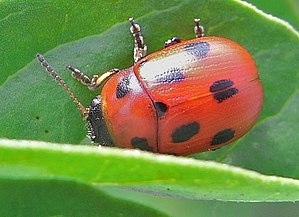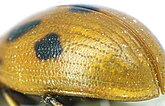Gonioctena fornicata
| Gonioctena fornicata | ||||||||||||
|---|---|---|---|---|---|---|---|---|---|---|---|---|

Gonioctena fornicata |
||||||||||||
| Systematics | ||||||||||||
|
||||||||||||
| Scientific name | ||||||||||||
| Gonioctena fornicata | ||||||||||||
| ( Brüggemann , 1873) |
Gonioctena (Spartomena) fornicata ( syn .: Phytodecta fornicata ) is a beetle fromthe leaf beetle family and the subfamily Chrysomelinae . The generic name "Gonioctena" (from ancient Greek : γωνία, gonía "corner" and κτενός ktēīs, ktenós "comb") refers to the comb-like arranged teeth on the rear edge of the splint (Fig. 5, arrow B). The species name "fornicatus" ( Latin ) means "arched" and refers to the pronotum . The name of the subgenus Spartomena alludes to the fact that the animal to Spanish broom (from the Greek .: σπάρτος spártos "Spanish broom") can be found. The species isknownas a lucerne pest in Eastern Europe, but is rather rare in Central Europe.
Characteristics of the beetle
The beetle is slightly more elongated and flatter than a ladybug . It reaches a length of five to seven millimeters. The drawing varies a lot. In the almost black forms, only individual points or parts of the edge are red; in the other extreme, the entire beetle is red or red-yellow with the exception of four dark points on the wing covers. In the intermediate forms, there can be two points or spots on the pronotum, and four, five, six or seven points on the elytra. In addition, the dots can flow together to form black areas.
The head is drawn into the pronotum up to the eyes . The eleven-segment antennae become thicker on the outside. They are pivoted away from each other on the forehead over the root of the upper jaw (Fig. 2). The upper jaws are not hollowed out laterally (for the insertion of the jaw probe end link).
The pronotum is strongly arched (name fornicatus ), while it is flatter in many other species of the genus and especially in the similarly drawn species Gonioctena viminalis . In addition, the pronotum is finely and densely punctured ; the dots on the sides are only slightly stronger (Fig. 3). Behind the center of the reddish-yellow pronotum are typically a pair of black round spots.
The rough points of the elytra form nine distinct rows; the seventh row of dots behind the middle is also not resolved by dots placed next to it (Fig. 1), at most somewhat irregular. The lateral edges of the elytra are not ciliate at the tip. The epipleurs terminate backwards and are bent back inwards (bent under). Typically there are five or seven points on the wing covers, with one point on the wing cover seam roughly in the middle, the remaining points being symmetrically distributed over the wing covers. The label is black.
All rails are deepened like a channel on the upper side towards the tarsi; in this recess can tarsi be folded upward. The outer edge of this groove is drawn out into a tooth, which in the middle and rear rails is at the end near the tarsi ((Fig. 4), in the front rails the tooth is removed from the deflection of the tarsi and is weaker (Fig. 5, Arrow A). The reddish tarsi are all four-limbed, but in leaf beetles a thickening on the claw limb can be interpreted as a rudimentary additional tarsal limb (with the number 4). The third tarsal limb is outlined above, but not clearly bilobed. The claws are on the Provide the base with one tooth each (Fig. 5, arrow C).
 Fig. 1: wing covers from behind Fig. 2: head Fig. 3: pronotum laterally (head left)   |
 Fig. 4: Underside Fig. 5: Front leg Arrow A: tooth Arrow B: “comb” Arrow C: toothed claw  |
biology
Old information about rowan berries and gorse as host plants are viewed critically today, the species is classified as a pest on alfalfa and clover . The larvae mainly eat leaves and young shoots, the beetles probably also older shoots.
The beetle has a one year development cycle. It hibernates as an imago at a depth of five to twenty-five centimeters. The beetles reappear in spring and can then become harmful in alfalfa crops ( Medicago sativa ) until the second half of June . After mating, the females lay between 200 and 1000 eggs in small portions, mostly on the lower leaves. The larvae go through four stages and are particularly harmful in the last two stages through leaf damage. After three to four weeks, the larvae dig into the ground to pupate. In the same year, the hatched beetles eat for another two to three weeks before they go into the ground again to overwinter.
distribution
The center of the distribution area is in south-eastern Europe. In Central Europe the species occurs only in the Czech Republic and Slovakia , there are old reports from Austria . In Hungary , the beetle and its larvae can become harmful if they occur in large numbers. The species is believed to be spreading. In any case, there are new reports of finds from Germany , Austria and the USA .
literature
- Heinz joy, Karl Wilhelm Harde, Gustav Adolf Lohse (ed.): The beetles of Central Europe . tape 9 . Cerambycidae Chrysomelidae . Spektrum Akademischer Verlag, Munich 1999, ISBN 3-8274-0683-8 (first edition: Goecke & Evers, Krefeld 1966).
Individual evidence
- ↑ a b Gonioctena (Spartomena) fornicata in Fauna Europaea. Retrieved January 16, 2011
- ↑ a b Sigmund Schenkling: "Explanation of the scientific beetle names"
- ^ Gustav Adolf Lohse, Wilhelm H.Lucht: Die Käfer Mitteleuropas . 3. Supplementary volume with catalog section. Goecke & Evers, Krefeld 1994, ISBN 3-87263-045-8 .
- ^ A b Klaas Reissmann, Christoph Benisch, Horst Kippenberg: " Gonioctena fornicata (BRÜGGEMANN, 1873), new discovery for Germany" Mitt.ent.V. Stuttgart, vol. 53, 2008
- ^ Atlante di Entomologia Agraria - Insetti utili e dannosi